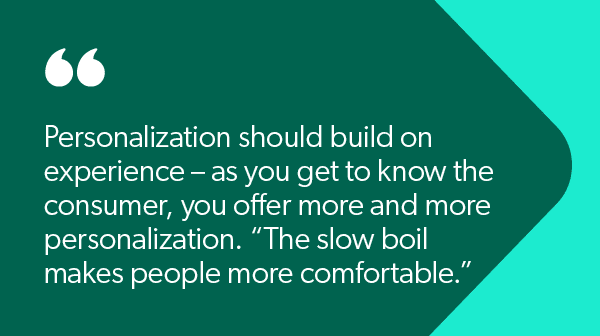Invisible banking sounds like something out of a tech noir movie – behemoth financial institutions doing things outside of the government eye, evil villain style.
It is all about enabling your customers to make financial transactions and decisions without having to think about them.
Consider when you are making a biggish online purchase, and the site shows you a financing option. Or, when you check mortgage rates there is an option to apply now. Experts believe that it will continue to evolve so that we can ask a digital assistant, such as Alexa, to make restaurant reservations or book a yoga class — and pay for it — without any human interaction.
That’s invisible banking, and it’s the culmination of many trends in banking.
And personalization (relevancy?) in banking is at the heart of it.
Fintech applications have long aimed to give consumers more control over their finances. Despite this goal, many retail banks have failed to deliver seamless applications and some make multiple applications for different functions at their banks.
That’s changing. FinTech and banks are working together to offer more services to customers – and often those services are embedded in other apps.
Embedding might sound like “hidden,” but think about how you see a map on every company’s location page – that map is embedded on the page and in other apps. You don’t have to navigate to the maps app on your phone to use it – now you just click.
What is Embedded Banking?
Embedded banking apps work in the same way. As you’re shopping, you can click on one button to purchase, finance, and even comparison shop for better prices. This function can be so well hidden that the consumer might think credit, for example, is provided by the retailer instead of the bank.

American Banker says that invisible banking includes financial wellness applications. These apps offer in-the-moment advice to help consumers make healthy financial decisions.
They may help people save without making a conscious decision about it – like rounding up on transactions and pushing some into a savings account, for example. They also might help consumers find the best prices for items or tell them how to pay for purchases. Don’t have enough money in one account? Put it on a 0 percent interest card or split it across two accounts to avoid overdraft fees. These apps will be able to do it all – and consumer data is key.
Everyone is getting in on it, according to Forbes. Rideshares businesses, telecommunication companies, and tech giants all offer some form of digital wallets and payment options.
Invisible Banking Requires Data – Lots of It
We know that every site and every app collects data on users – we have to explicitly agree to it, after all. But how they use that data can be a mystery. More and more, banks, fintechs, and enterprises are sharing data they have about users – so they can offer consumers personalized options that serve their unique needs and circumstances.
More financial institutions are participating in open banking, which allows access to consumer banking information and other financial data to third-party financial service providers and other non-bank financial institutions through the use of application programming interfaces (APIs).
In fact, EU regulations require financial institutions to participate in open banking, which some believe will drive innovation into the near future. “In the ‘marketplace banking’ model that would result from this, customers will be able to use a single banking interface to access products and services from a multitude of players, including incumbent banks, challengers and FinTechs,” according to Deloitte.
This data sharing among specialized providers helps banks and fintech extend their reach beyond their own technologies.
American Banker quotes Phillip Rosen, CEO of the fintech Even Financial, as saying “that such interactions are the hallmark of the future in which banking becomes embedded in other activities.”
All of this data is how banks and fintechs will make invisible banking ubiquitous – the more they know about you, the more they can reduce the friction of conducting life’s business. According to SalesForce report on the connected customer, 52 percent of customers expect personalized offers.
In addition, “… customer experience is the new driver of brand value and competitiveness in retail payments,” Accenture wrote in its report “5 Big Bets In Retail Payments in North America.”

Relevancy Overcomes Privacy Hesitancy
This is where the evil villain image comes in — to create these frictionless transactions and to offer consumers the best experience possible, banks have to both offer data about consumers and take in third-party data about them.
Consumers could feel creeped out about that much of their data being bandied about. At Coveo’s Relevance 360, Seth Godin, entrepreneur and author, said, “Personalization sort of creeps people out, because if you run into someone, and you don’t know them but they know your name, you’re like, ‘Wow how did that happen?’”
But relevance is key to removing that creepiness, because when it’s personal, it’s what a consumer wants. Relevance changes the experience to deliver exactly what the consumer wanted. “It’s not about them,” Godin said. “It’s for them.
Bozoma Saint John agreed, saying that there are third rails to personal data use, and those rails are the consumers themselves. Personalization should build on experience – as you get to know the consumer, you offer more and more personalization. “The slow boil makes people more comfortable,” Saint John said. “We have to serve customers in a way that doesn’t creep them out, but we serve them more and more over time,” she said.
Serving customers with relevant products using that much data almost certainly means that machine learning and artificial intelligence (AI) will be involved.
The stakes are huge. “The potential for value creation is one of the largest across industries, as AI can potentially unlock $1 trillion of incremental value for banks, annually,” according to McKinsey.
That value will come from banks’ improved ability to personalize services, create distinctive omnichannel experiences, and innovate rapidly.
What is the Future of the Banking Industry?
AI will be at the heart of meeting consumers’ rising expectations of invisible, frictionless banking, but banks and fintechs have some trust-building to do.
“I always joke, we can put a satellite in space … but we can’t get our transactions categorized correctly,” Kristen Berman, behavioral scientist and co-founder of Common Cents Lab said in American Banker. “Transfers are still being categorized as spending in apps, which makes people not trust these types of apps to give you insights, which makes this useless. we don’t trust the insights that we’re being given.”
A platform powered by off-the-shelf AI will learn that an expense named “Verizon” should be under Telco. With every new user behavior and signal, the search becomes progressively richer and more relevant – automatically.
Some off-the-shelf AI vendors (Coveo included) also allow you to combine your personalization data with your existing data from your customer data platforms (CDP) and beyond. Obviously, the more data and platforms you connect, the more effective your AI-powered personalization gets, as signals captured on one digital property will inform your personalization strategy everywhere.
So while the technology may be invisible to your customers – the results should be quite discernable.
Dig Deeper
With more people online with higher expectations than ever before, banks certainly need to deliver an exceptional digital customer service experience. However, they also need to be prepared to handle customer issues that will inevitably arise as a result of this rapid digital shift.
To learn more about how to deliver the digital finserv experience customers expect and how to help them help themselves as they adapt, read Coveo for Financial Services: Become Their Most Trusted Advisor.
What industries outside of retail are doing a good job evolving for the future? What can retail learn from them? Tune in to Episode 5: The Future of Retail of our podcast, The Ecom Edge!


